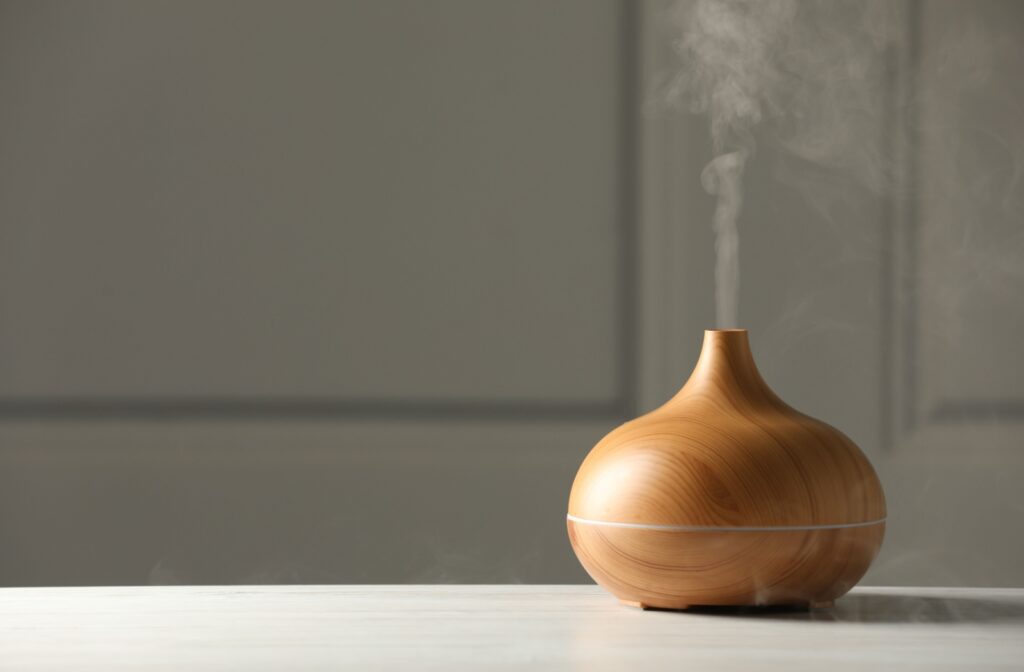If your eyes often feel gritty, itchy, or irritated, you know how uncomfortable dry eye syndrome can be. Many factors in our environment, like dry indoor air, can contribute to these symptoms.
One common solution is to use a humidifier. By increasing the moisture level in a room, a humidifier helps slow the evaporation of your natural tears, keeping your eyes more lubricated. This simple change to your environment can provide noticeable relief from irritation, especially when combined with professional eye care services.
What Causes Dry Eyes?
Dry eye occurs when your tears cannot provide enough lubrication for your eyes. This can happen if your eyes don’t produce enough tears or if they produce poor-quality tears that evaporate too quickly. Environmental factors like dry climates, wind, indoor heating, and air conditioning often make symptoms feel worse.
Common Symptoms of Dry Eye
You may be experiencing dry eye if you notice symptoms such as:
- A stinging or burning sensation
- Feeling like something is in your eyes
- Redness and irritation
- Blurry vision that fluctuates, especially after reading or screen time
- Watery eyes—a response to the irritation
Underlying Health Conditions & Dry Eye
Sometimes, dry eye is a symptom of another health issue. A comprehensive eye exam can sometimes find signs of conditions like Sjögren’s syndrome that contribute to dry eye.
The Role of a Humidifier for Eye Comfort
A humidifier works by releasing water vapour into the air, increasing the humidity level. For your eyes, this added moisture can slow down how quickly your natural tears evaporate. This, in turn, helps keep the surface of your eyes lubricated for longer, which may reduce feelings of dryness and irritation.
How Sleeping with a Humidifier Helps Dry Eyes
Using a humidifier overnight can be particularly helpful for eye comfort. The air in bedrooms often becomes dry from heating systems in the winter or air conditioners in the summer. Running a humidifier while you sleep helps create a more comfortable environment, helping you wake up with eyes that feel less dry and gritty. If you consistently find that your eyes hurt when you wake up, a humidifier is a great first step to try.

What Humidity Is Good for Dry Eyes?
A comfortable indoor humidity level is typically between 30% and 50%. You can use an inexpensive tool called a hygrometer to measure the humidity in your room. This allows you to adjust your humidifier’s settings to maintain a consistent and comfortable moisture level.
How to Choose a Humidifier
When you look for a humidifier, you’ll find a few different types and features. Instead of focusing on a specific brand, consider which features fit your space and your lifestyle. This approach helps you find a device that you’ll use regularly.
Types of Humidifiers
The two main types are cool-mist and warm-mist. Cool-mist humidifiers use a filter to release a cool vapour, while warm-mist models heat water to create steam. Both can effectively add moisture to the air and help soothe your eyes.
Features to Consider
A few practical features can make a humidifier easier to use and maintain:
- Room Size: Look for a model designed for the size of your room—whether it’s a small bedroom or a large living area.
- Ease of Clean: Humidifiers require regular cleaning to prevent the growth of mould and bacteria. Choose a model with a tank that’s easy to remove and wash.
- Automatic Shutoff: Many humidifiers have a feature that turns the device off automatically when the water tank is empty.
Humidifier vs. Air Purifier for Eye Comfort
People often confuse humidifiers with air purifiers, but they serve very different functions. A humidifier adds moisture to the air, which helps combat dryness. An air purifier, on the other hand, circulates air through a filter to trap irritants like dust, pollen, and pet dander, which can trigger eye allergies or allergic conjunctivitis.
If your eye irritation comes from airborne allergens, an air purifier might provide more relief. If the problem is dry air, a humidifier is the device that addresses that directly. In some cases, using both devices may help you address both air quality and humidity levels for greater comfort.
Professional Care & Lifestyle Habits
While a humidifier can provide relief from symptoms, it’s just one part of an effective dry eye management plan. Adopting other good habits can further support your eye health.
We suggest that you try the following:
- Take Screen Breaks: When you use a computer or phone, you tend to blink less, which can lead to digital eye strain. Try the 20-20-20 rule—every 20 minutes, look at something 20 feet away for 20 seconds.
- Stay Hydrated: Drinking enough water throughout the day supports all of your body’s functions, including tear production.
- Protect Your Eyes Outdoors: Wear wraparound UV-blocking sunglasses to shield your eyes from wind and sun.
When to Visit Your Optometrist
If lifestyle adjustments and a humidifier don’t provide enough relief, professional care can help. At EyeCare Niagara, we can conduct an eye exam and use the results to discuss your options moving forward. These may include specific types of eye drops or other dry eye treatments tailored to your needs. Don’t hesitate to contact us today.




